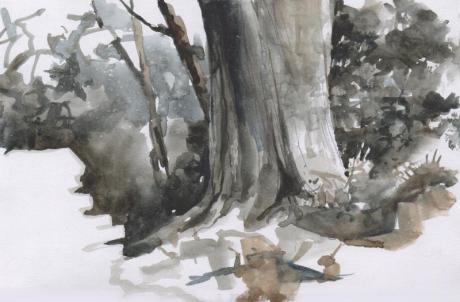
This is my Teddy bear, Treacle. We became companions when I was around the age of two, and as we’re now well past 60 we’re both showing signs of age (although I’m glad to say my legs are not in danger of falling off, and I’m not quite as threadbare as he is, either). I’ve been drawing and photographing him a lot lately because of a project at Cliffe Castle involving Teddy bears.
Even though I’m extremely familiar with the way he looks, in the last couple of weeks all this work we’ve done together has made me examine his features a lot more carefully, and I’ve been musing about his origins and his ancestry.
I’m very fond of this small bear, so much so in fact that drawing him can be difficult. He has a deceptively simple head – not a classic bear shaped face as he has no real snout – though I’ve seen others a bit like him, like these delightful little ones in the V&A – they’re obviously related.

Three small antique bears in the V&A collection, in the Bethnal Green Museum of Childhood. (The drawing is part of a limited edition of prints of Teddy bears that I did in the 1990’s)
But because he’s such a simple shape, any subtle mistake is immediately obvious and that really matters, so I’ve spent a lot of time and effort trying to get his features right. He has a very definite personality. And the more I look at him, the more I draw him, the more I realise that he reminds me of someone else who was important to me, growing up. One of my greatest heroes – Noggin the Nog.

Images of Noggin the Nog by Peter Firmin, courtesy of Smallfilms; drawings and photos of Treacle by me
I think you’ll see what I mean.
Noggin, and the whole Land of Nog were created by Peter Firmin and Oliver Postgate and the first stop-motion film, The Saga of Noggin The Nog was made by them for children’s television in 1959 when I was 5 years old (these images are from around that time – later series followed, and books, and much later, colour versions of some of the videos came out). The films were narrated by Oliver Postgate, and listening again to the lines that began every story, the sound of his voice has an uncanny way of transporting me in time…..
‘In the Lands of the North, where the black rocks stand guard against the cold sea, in the dark night that is very long, the men of the Northlands sit by their great log fires and they tell a tale…’
(I probably don’t need to tell you that the Noggin sagas have always had a devoted following and still have even today, and happily several of these early episodes are on YouTube). An informative website here gives a clear explanation of all the characters and stories.
Many people will fondly remember the books with their coloured illustrations but for me the haunting, strange, dark tales told on TV in black and white were always more powerful and compelling. They are stories of cheerfulness, courage and challenging adventure mixed up with the dullness of the everyday, where it’s always mild manners and politeness which end up solving intractable difficulties.
Peter Firmin based his designs for the Nogs on the Lewis chess pieces in the British Museum, found on a Hebredian beach in the 1830’s.

Drawings of Noggin the Nog and Thor Nogson by Peter Firmin courtesy of Smallfilms, and the Lewis chessmen from the British Museum
So do Noggin and Treacle share the same ancestry? I doubt it. It seems that they came into being at around the same time, but I think I was simply drawn to them both for being what they were – and still are.
I’m grateful to both of them for a lifetime of companionship – I’ve a feeling my life would have been very different without them. They’ve given me a sense of optimism and adventure, and been a consolation in dark times. They’ve helped me to think creatively about solving problems and how to move bravely forward. And above all, they’ve been a shining reminder (and how badly we all need this today!) that whatever you’re faced with, politeness, respect, and good manners can make all the difference, no matter what.



























































